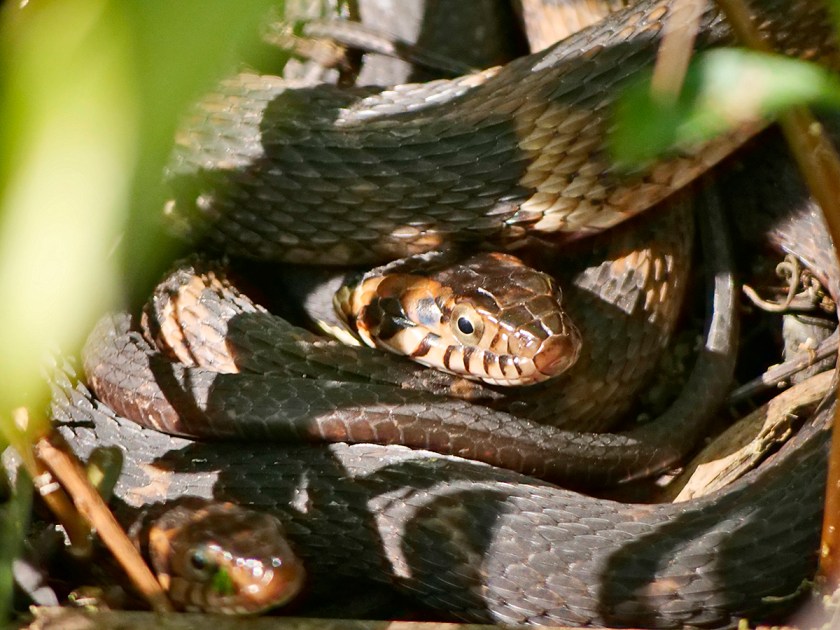There are many ways to discover amphibians and reptiles – you can road-cruise for them, flip rocks and logs and trash, or even just walk them up. But if you haven’t made use of boardwalks, you’re missing out. There are a lot of boardwalks out there in parks, preserves, and natural areas, and birders make good use of them. As it happens I’ve spotted a number of interesting herps from boardwalks crowded with birders, all of them looking up or out while my focus is considerably closer to the ground.

Boardwalks typically allow access to wet areas like swamps or marshes, and this past April I spent some time at a swamp boardwalk in the Jean Lafitte National Historic Park and Preserve near New Orleans, Louisiana. I made two trips there, one with some friends in early April, and an early morning solo visit a few weeks later. In both instances snakes, lizards, and frogs were plentiful, and I got to spend some time just watching (and hearing) them do what they do.

One of the things I liked about this boardwalk was that the traffic was in the Goldilocks zone – not too heavy, and not too light. Too many visitors makes it difficult to quietly observe wildlife, and you won’t believe how oblivious some people are – they’ll step in front of your binoculars, or come up and stand next to you while you’re shooting photos and scare the critter away with “what’re you shooting?”. Too few visitors, and animals may be skittish – they do seem to habituate to some degree of noise and movement coming from the boardwalk.

The boardwalk has some curves to it, and it also zigzags back and forth, breaking sightlines and adding to the solitary feel of the place, and in some cases, you can view wildlife from a number of different angles.

On my visits, the number of species that I observed was fairly low, but I saw many of most kinds. Perhaps the most common herps were anoles, both the native Carolina Anole (Anolis carolinensis) and the introduced Brown Anole (Anolis sagrei). Both species were amazingly common, and by walking slow and looking about carefully, I saw individuals every few feet, moving about in the vegetation or basking in the sun.

Gulf Coast Ribbon Snakes (Thamnophis proximus orarius) were also abundant, and I observed nearly all of these in sunny places. I saw dozens of them on my second visit in the morning, when the warmth of the rising sun brought ribbons out everywhere.

Often there would be two or three ribbon snakes lying intertwined together, on low vegetation quite close to the water, but some were out basking on the boardwalk itself, or stretched out on limbs and branches close by. I nearly had the boardwalk to myself on my second visit, so I was able to spend considerable time watching and photographing ribbons without interference.

Despite their abundance, I had to remind myself that I was only seeing the ribbon snakes around the boardwalk area – there were untold numbers of them elsewhere in the swamp, and plenty of frogs for them to eat.

At night, I saw a number of Pig Frogs (Lithobates grylio), lying in wait close to the boardwalk, and I could hear many males further out, making their grunting calls. Other frogs were calling as well, including Bird-voiced Treefrogs (Hyla avivoca) and Squirrel Treefrogs (Hyla squirella).

During the day, Green Treefrogs (Hyla cinerea) were the most abundant amphibian, and I lost count of how many I observed, many of the them cozied up to something similar in color.

I’m accustomed to seeing Five-lined Skinks (Plestiodon fasciatus) in swampy places, and I wasn’t disappointed – some were running about the floorboards and rails of the boardwalk, while others basked and hunted on tree trunks and logs. Water does not seem to hinder them, and they will swim readily, and will sometimes duck under the surface if you approach too close.

I saw a few Cottonmouths (Agkistrodon piscivorus) from the boardwalk, but only got a few photos. They weren’t very photogenic on either day, at least for me.

The harmless Broad-banded Water Snake (Nerodia fasciata confluens) was more abundant, and I even watched a copulating pair for a while, in some thick brush.

Near the end of my second visit, I spied a Black-masked Racer (Coluber constrictor latrunculus) basking on the boardwalk rail. As I set up to shoot it with my long lens, two people approached it from the other direction. They were so intent in their conversation that neither saw the snake, or that they had stepped into my shot, or that the sky was blue and the earth was round and a host of other things. As I said this happens often and all I can do is shake my head and hope that one day something in the world around them will catch their attention.

Reluctantly, I had to leave one of my better boardwalk experiences behind, and face the long 13 hour drive home. I hope I can return to this boardwalk in Jean Lafitte someday, and of course, I will look for similar opportunities elsewhere.
Glad you touched on boardwalk herping. And great ribbon shots!!
Thank you!